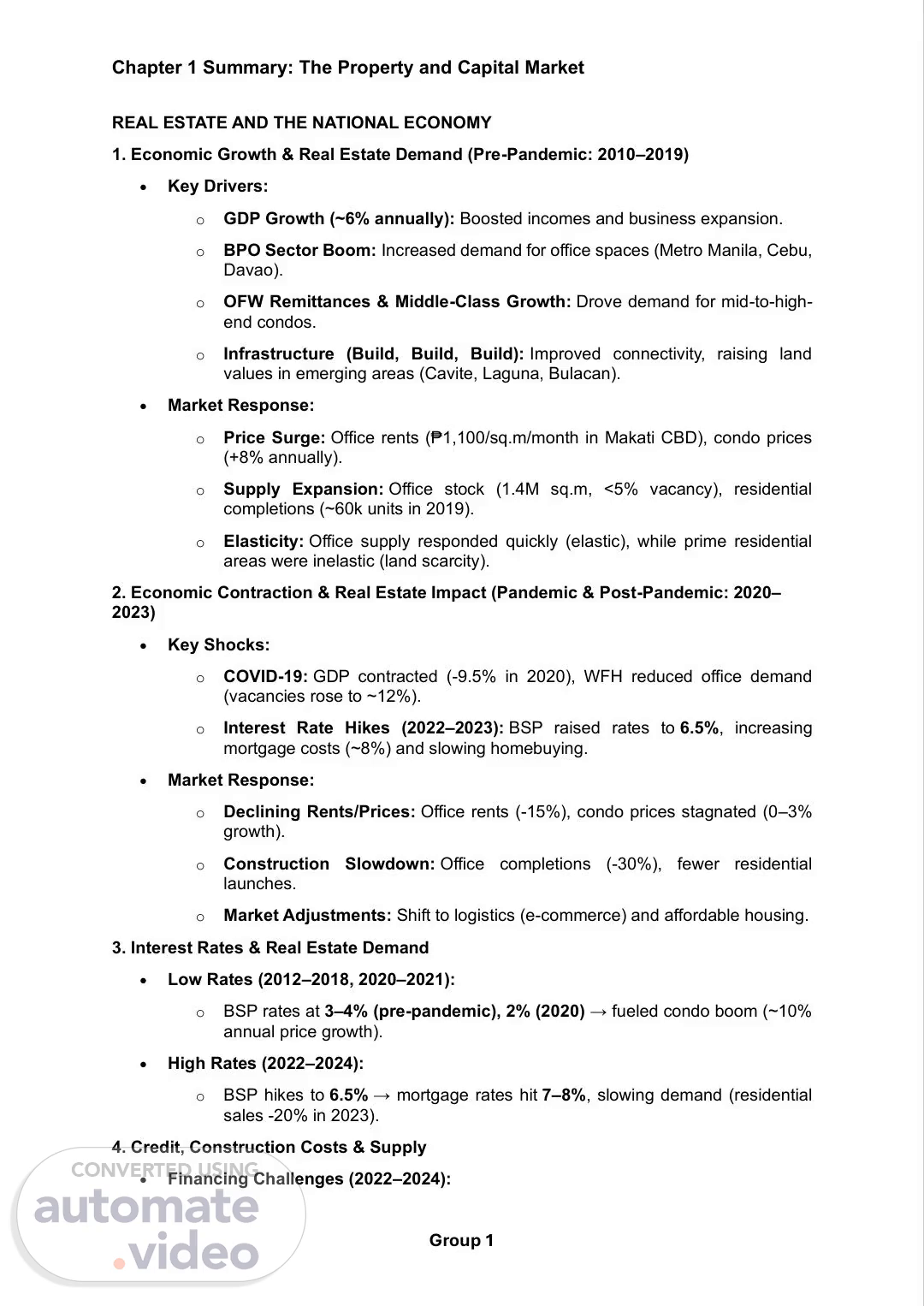
REM 13 Chapter 1-Part 2 Word- Review Material PBGERIDA Group 1
Scene 1 (0s)
[Audio] Chapter 1 Summary: The Property and Capital Market REAL ESTATE AND THE NATIONAL ECONOMY 1. Economic Growth & Real Estate Demand (Pre-Pandemic: 2010–2019) Key Drivers: o GDP Growth (~6% annually): Boosted incomes and business expansion. o BPO Sector Boom: Increased demand for office spaces (Metro Manila, Cebu, Davao). o OFW Remittances & Middle-Class Growth: Drove demand for mid-to-highend condos. o Infrastructure (Build, Build, Build): Improved connectivity, raising land values in emerging areas (Cavite, Laguna, Bulacan). Market Response: o Price Surge: Office rents (₱1,100/sq.m/month in Makati CBD), condo prices (+8% annually). o Supply Expansion: Office stock (1.4M sq.m, <5% vacancy), residential completions (~60k units in 2019). o Elasticity: Office supply responded quickly (elastic), while prime residential areas were inelastic (land scarcity). 2. Economic Contraction & Real Estate Impact (Pandemic & Post-Pandemic: 2020– 2023) Key Shocks: o COVID-19: GDP contracted (-9.5% in 2020), WFH reduced office demand (vacancies rose to ~12%). o Interest Rate Hikes (2022–2023): BSP raised rates to 6.5%, increasing mortgage costs (~8%) and slowing homebuying. Market Response: o Declining Rents/Prices: Office rents (-15%), condo prices stagnated (0–3% growth). o Construction Slowdown: Office completions (-30%), fewer residential launches. o Market Adjustments: Shift to logistics (e-commerce) and affordable housing. 3. Interest Rates & Real Estate Demand Low Rates (2012–2018, 2020–2021): o BSP rates at 3–4% (pre-pandemic), 2% (2020) → fueled condo boom (~10% annual price growth). High Rates (2022–2024): o BSP hikes to 6.5% → mortgage rates hit 7–8%, slowing demand (residential sales -20% in 2023). 4. Credit, Construction Costs & Supply Financing Challenges (2022–2024): Group 1.
Scene 2 (1m 13s)
[Audio] Chapter 1 Summary: The Property and Capital Market o High borrowing costs → project launches dropped ~20%. Rising Construction Costs (2021–2024): o Steel, cement, labor costs up 20–30% → developers shifted to prefab/modular construction. Regulatory Delays: o Metro Manila zoning/permit issues → pushed developers to provinces (Cebu, Clark, Davao). 5. Public Policy & Housing Programs Affordable Housing: o Pag-IBIG loans (5–7%) supported mass housing (e.g., Bulacan, Cavite). o Socialized Housing Law (RA 7279): Requires 20% of projects for low-cost housing. Tax Policies: o REIT reforms (2021): Lowered public float to 33%, encouraging listings. o VAT exemptions for socialized housing (units below ₱2M). 6. Financial Institutions & Regulations Residential Financing: o Pag-IBIG, bank loans fueled pre-pandemic condo boom. Commercial Real Estate: o BSP Basel III rules tightened lending for risky projects. o 60-40 foreign ownership rule limited large-scale investments. Key Takeaways: 1. Cyclical Market: Real estate responds strongly to GDP growth, interest rates, and sectoral demand (BPO, OFWs, infrastructure). 2. Supply Constraints: Construction costs, zoning delays, and credit tightening limit supply elasticity. 3. Policy Impact: Government housing programs and tax incentives shape affordability and developer activity. 4. Future Outlook: Recovery depends on interest rate cuts (2025+), infrastructure completion, and REIT expansion. The Philippine real estate market remains volatile but resilient, with long-term growth tied to economic policies and global trends. Group 1.